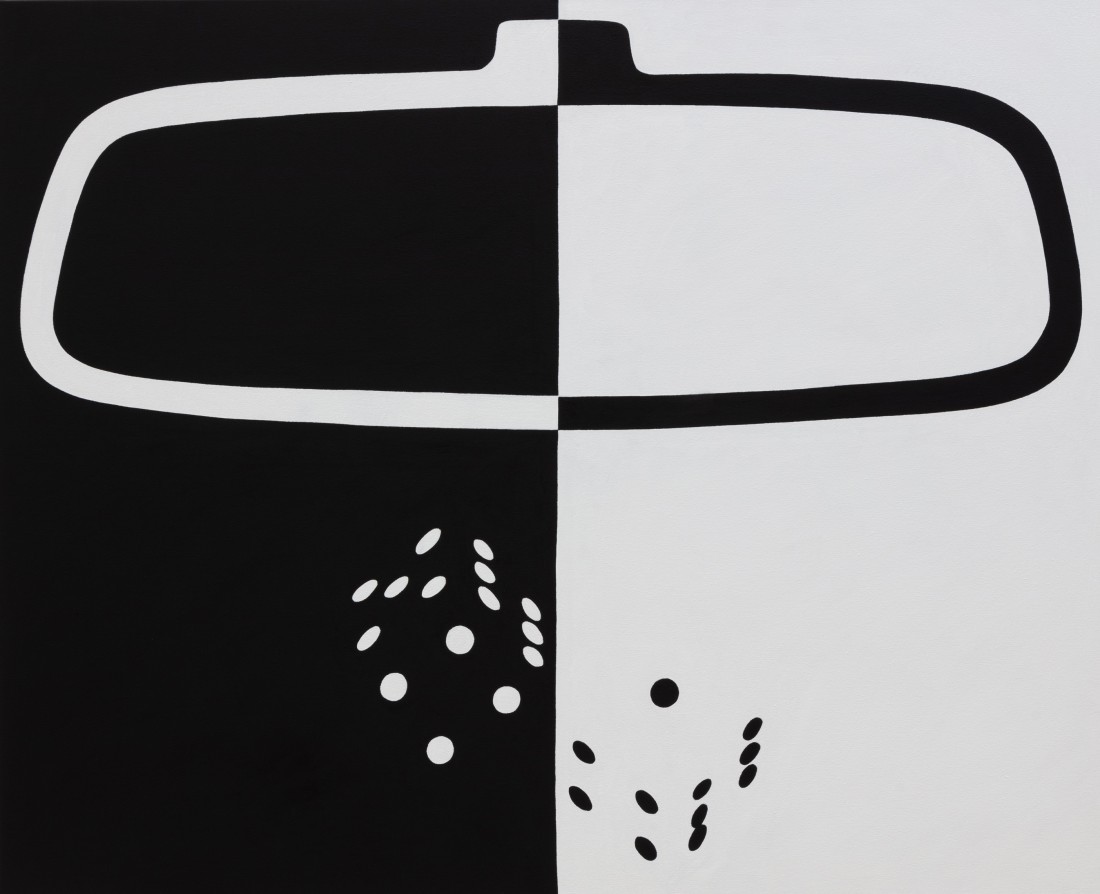Yan Wen Chang: Magnum Noirus
The title of Yan Wen Chang’s most recent exhibition at Susan Hobbs Gallery in Toronto, “Odile’s Notorious Magnum Opus of Thirty-Two Fouettés,” offers a series of clues to the layered workings of the imagination of this Guelph-based artist. The main reference is to Tchaikovsky’s ballet Swan Lake, 1875–76, now regarded as the most demanding ballet in the history of the art form. The two principal roles, the ethereal Odile and the seductive Odette (the black and the white swan), are both danced by the same ballerina, and among the necessary moves are the 32 fouettés that Odette performs to seduce Prince Siegfried into breaking his vow to Odile. The prince and the princess die together in sacrificial bliss.

Yan Wen Chang, Hollywood Painting No. 5, 2022, oil on canvas, 106.5 x 106.5 centimetres. All photos by Laura Findlay. All images courtesy Susan Hobbs Gallery.

Yan Wen Chang, Origin Story, 2022, oil on canvas, 106.5 x 106.5 centimetres.
What Yan finds most appealing about the ballet is not the sentiment but the palette; she is already known for framing her painting practice within the black and white, and then finding inside that colour frame touches of red, blue and tones of grey. All 10 of the works were made for the exhibition, and they include variations on her continuing investigation “of the realities of the American Dream; one hopeful and defiant and the other hopeless and desperate.” But Yan’s naming goes beyond the ballet; the “notorious” is a reference to Notorious BIG, called by Rolling Stone “the greatest rapper who ever lived,” and the Latin phrase “magnum opus” addresses the scale of her intentions. Everything about Yan’s art making aims for intensity.
Among the paintings in the exhibition is Origin Story, 2022, a spiral of written language in the form of a rap lyric delivered by an enraged former lover. The lyrics, “ex-lover of champagne, cocaine, top-tier insane fuck fame fast lane all hustle no luck she just don’t give a fuck,” are a disguised telling of her own story: leaving Malaysia alone for Toronto at the age of 17, getting involved in the drug scene, addiction, going clean and willing herself to become a painter. “I try not to make things autobiographical; however, I do like paintings that talk about the self. Not me specifically but about the combative battle of the self’s polar opposites.” Those opposites are cleanly executed in the black and white halves of Mirror Effect, 2022, where below the interior mirror of a car is a pair of formless dice, indicated only by dots hanging in space. Yan has found an economic reduction in her painterly language. Her self-portraits show her eyes or her mischievous Cheshire smile; in Portrait of Self at Final Destination, 2022, her eyes are behind a gun that could have come out of the pages of a graphic novel like Sin City. Her paintings are noir-y.

Yan Wen Chang, Portrait of Self at Final Destination, 2022, oil on canvas, 66 x 142 centimetres.

Yan Wen Chang, Mirror Effect, 2022, oil on canvas, 106.5 x 132 centimetres.
The other influence in her work comes out of American painters from opposite ends of the continent: the night paintings of Alex Katz, Jasper Johns and his five-point stars and Ed Ruscha and his play with language. In Hollywood Painting No. 5, 2022, she combines Ruscha’s Hollywood with the Hollywood Nail Salon on Dundas Street in Toronto that she used to walk by every day on her way to her studio. But her appropriation gets attenuated when the stretch of the letters reflects the fish-eye lens used in Skate culture to make the entire trick visible from one angle. “This street shit will never leave me,” she says when asked about her references. “You can take the girl out of the hood, but you can’t take the hood out of the girl. I strongly believe that the street sensibility will always find its way into my work.” The title of the largest work in the exhibition, Grand Slam, 2022–23, references the highest achievement in tennis, and says something about Yan’s commitment to the materiality of paint and her ambition: “I worked on it for over eight months and it really tested my endurance, determination and, for sure, patience.” It’s her painted version of the 32 fouettés, and through its subtlety and nerve, the painting shows that she can dance as both the white and the black swan. For her, the magnum opus is a work-in-progress. “It sounds naïve,” she says, “but I always think my next painting will be my best.” ❚

Installation view, “Odile’s Notorious Magnum Opus of Thirty-Two Fouettés,” Susan Hobbs Gallery, Toronto, 2023.

